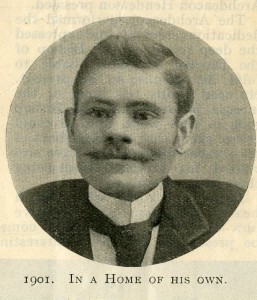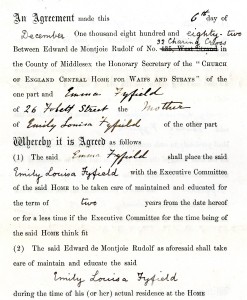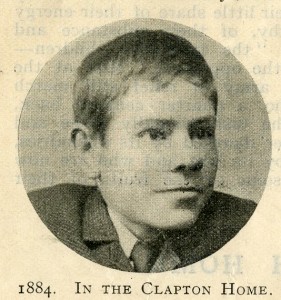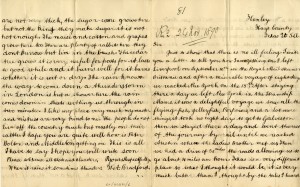Today we have the second part of a blog post written by one of our volunteers, David Lamb, that looks at seven individual stories from the first one hundred children taken into the care of the Waifs and Strays’ Society – you can read the first part here: http://www.hiddenlives.org.uk/blog/2015/12/the-first-one-hundred-children-a-new-beginning/
The Waifs and Strays’ Society, the original name of The Children’s Society, was founded in 1881. Applications for children to be taken into the care of The Society started in February 1882 and are kept in case files for each child. The the first part of this blog was an analysis of the first hundred case files, all started in 1882. There is considerable variation in the amount and quality of information in the files, many containing just the application form often only partially completed, with brief notes of any subsequent moves on the back of the form. Some files contain correspondence, often about maintenance payments.
Individual children’s stories
Case 1: The Society’s First Boy – John was eleven years old and living in Brixton, south London, when the application was made by the parish visitor. His father was a labourer who earned sixpence (6d) an hour when he was in regular work. Their large family was poor and seldom remained in the same house for more than a few months. The parish visitor describes his parents as “two of the most wretched and degraded people in the neighbourhood”.
When John was seven, he fell on ice injuring his spine, and was then badly burnt. He never fully recovered from these accidents. He worked as a crossing sweeper at Clapham Common, but his health deteriorated with neglect. He was taken into an orthopaedic hospital and from there was moved to several convalescent homes. John was then taken into St Michael’s Hospital for sick and destitute incurable children in Shoreditch, but he could not be kept there due to his improving health.
He was received into the Clapton Home of the Society in south London, during February 1882, then spent seven months in a succession of privately run convalescent homes in Southend-on-Sea, Essex, followed by a similar time in a foster home in Balham, south London. After a further seven months in a training home for disabled children in Kensington (possibly the Crippled Boys Home, Wright’s Lane, Kensington, London), he returned to the Clapton Home. At seventeen, he was given a year’s trial as a clerk at St Mark’s Home, Natland near Kendal, making The Society’s first connection with that home. He went on to develop a career in the printing trade in London, Redhill and Oxford.
His case file is unusual in that it contains regular correspondence up to his death at 59 from tuberculosis in Frome, Somerset, in 1930. He married in 1897 and had a daughter seven years later. He wrote verse and was fulsome in his praise and support for The Society. The Society also held him in high regard, given his success in life, achieved in the face of considerable adversity.

A photograph of John seventeen years later as an adult, that appeared in the same edition of the ‘Our Waifs and Strays’ magazine.
Case 2: An Orphan Girl – Florence was seven years old when her maternal grandmother referred her into The Society’s care. Her father, a bombardier in the Royal Horse Artillery, deserted from the army soon after marrying her mother. He was pardoned, but deserted again, went to sea and was drowned. Her mother, a cook in the household of a Royal Artillery colonel, remarried but had died a month before the vicar in Woolwich applied to The Society to take Florence into its care.
Florence’s grandmother had children of her own to support and was looking after Florence’s half-sister who was very delicate. The vicar regarded her as “a really respectable woman only most unwisely married a very unsteady man who has been a constant expense to her. She is most anxious that her grandchild should be kept from evil and ready to give her up …”
Florence was received into the Dulwich Home, where she stayed for nineteen months. She then moved on briefly to a home in Harrow, before staying a while in a home not operated by The Society in Bayswater.
Case 3: A Destitute Boy – John, 16 years of age, was found “quite destitute” on the streets in Whitechapel at 2am and was sent to the Clapton Receiving Home “by order of the Rev. R C Billing, Rector of Spitalfields and Rural Dean”. His mother had died in Cardiff and his father “not known”, but thought to be living. He had a sister but did not know where she was.
He had been living in Kent, but had left his job in the ropeyard at Minster on the Isle of Sheppey, Kent, eight months previously. He joined a troupe of tramps known to the police, but left them after four months. He had “been getting his living by working around the Billingsgate fish market in London, going to the Derby and other races and there assisting pedlars, coconut men, etc”. He absconded from the Clapton House home after a month and joined the Notting Hill Shoe Black Brigade.
Case 4: Neglected Child to an Apprentice Carpenter – Edward’s father, a compositor had died three years previously, and his alcoholic mother neglected her six children. They were “left to run about the streets, almost destitute of food and clothing.” His mother kept losing work through drunkenness and pawned clothes given to her for the children. Edward fell seriously ill brought on through neglect, ending up in Westminster Hospital.
Edward was signed over to the care of The Society by his mother just before his eighth birthday and was received into the Clapton Home. He transferred to the Boys Home in Frome, Somerset, where at the age of 13 he was taken on as an apprentice for a local carpenter and builder. The apprenticeship indenture commits Edward to working 57 hours per week for his Master for seven years, starting at 2/6 per week (12.5p) rising to 10/6 (52.5p) per week in his final year, with two days annual holiday – Christmas Day and Good Friday.
Case 5: Happy emigrant to America – Since William’s mother died of tuberculosis four years previously, his “seldom sober” father had led “a wandering vagrant life”, deserting, neglecting and ill-treating his children. Four of William’s older siblings had been rescued by the Perseverance Association and William was taken into the Clapton Home aged seven. Two and half years on, he was transferred to an orphanage near Banbury for a couple of years, before moving on to the Standon Farm Home in Staffordshire for three years.
He returned to London to the Jersey Working Boys Home in Blackfriars for four months before emigrating to a farm in Texas run by the brother of a lady supporter of The Society in Devon. In a splendid letter, half of which is reproduced below, William describes the journey and how different farming is in Texas. “After a miserable voyage of eight days” from Liverpool to New York, “it was a delightful voyage” onward to Galveston – “we saw all the flying fish, jelleyfish [sic], porpoises, and a lot more things”. He went on by rail to Austin, then “had a drive of 35 miles, the roads allowing us to go about 4 miles an hour”.
“Texas is a very different place to what I thought it would be, it is very much better than I thought by the tales I heard in England … The horses, cows and pigs run wild … we have 215 sheep we had 252 but the wolves have ate the rest … at night we can hear them howl as though they ment (sic) to eat all the lot. … The pigs are very fond of watermelons which grow here to perfection and peaches. … The maise [sic] and cotton and grapes grow here too. … a thunderstorm in London is but a shower here. … I like my place very much – my master and mistress are very kind to me.”
Case 6: Army daughter left in care – Nine-year old Catherine and her little brothers were left living in the army’s Woolwich Barracks with only a thin partition dividing their bed from all the men when their father, a gunner in the Royal Horse Artillery, was put in prison. Their mother had died of sunstroke, probably when stationed abroad with her husband.
Catherine went into the Old Quebec Street Home in Marylebone in London, and the War Office deducted 3d (1p) daily from her father’s salary as a contribution to her maintenance. A little over a year later her father was discharged from the army (time expired) and emigrated to America with her eldest brother to live with her aunt and her sickly husband. A letter from a company in Massachusetts indicated that her father had left their employ “in consequence of irregular and intemperate habits”.
When Catherine reached 14, she had a spell at the Sea Bathing Infirmary, Margate, which usually dealt with tubercular patients. A few months after returning to the Marylebone Home, she went to work locally in domestic service, before going to India with a married couple, presumably as their servant.
Case 7: A Familiar Route into Service – Twelve year-old Emily had lost her father, a merchant seaman formerly in the navy, who was washed overboard and drowned. Her mother struggled to support her four children and was constantly anxious when out at work about Emily who was pilfering small articles from the neighbours.
Emily was taken into the Marylebone Home for Girls for a couple of years under the terms of the agreement extract below, and then spent a few months in a foster home before going into domestic service in Bournemouth.

An agreement placing Emma in the care of the Society’s Central Home for Waifs and Strays, dated 6 December 1882.
For information about The Children’s Society Archive’s ‘Hidden Lives Revealed’ web site: http://www.hiddenlives.org.uk/
or you can consult the Archive’s on-line catalogue: http://www.calmview.eu/childrensociety/Calmview
If you would would like to know about how The Children’s Society continues to change children’s lives today, visit the charity’s website: http://www.childrenssociety.org.uk/



